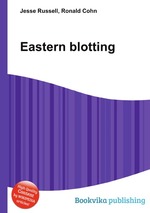Eastern blotting
Jesse Russell Ronald Cohn
бумажная книга
High Quality Content by WIKIPEDIA articles! Eastern blotting is a biochemical technique used to analyze protein post translational modifications (PTM) such as lipids and glycoconjugates. It is most often used to detect carbohydrate epitopes. Thus, Eastern blotting can be considered an extension of the biochemical technique of Western blotting. Multiple techniques have been described by the term Eastern blotting, most use proteins or lipids blotted from SDS-PAGE gel on to a PVDF or nitrocellulose membrane. Transferred proteins are analyzed for post-translational modifications using probes that may detect lipids, carbohydrate, phosphorylation or any other protein modification. Eastern blotting should be used to refer to methods that detect their targets through specific interaction of the PTM and the probe, distinguishing them from a standard Far-western blot. In principle, Eastern blotting is similar to lectin blotting (i.e. detection of carbohydrate epitopes on proteins or lipids); however, the term lectin blotting is more prevalent in the literature.


